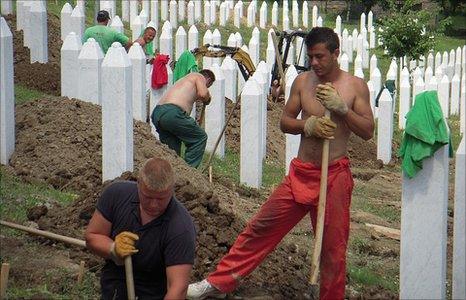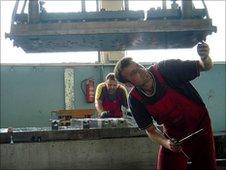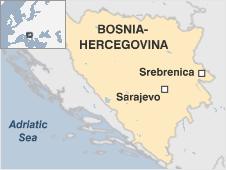Living with the memories of Srebrenica, 15 years on
- Published

Fresh graves are still being dug 15 years after Europe's worst act of mass murder since World War II
As he roars around the streets of Srebrenica in his three-tonne, self-built, bright red Hummer, Rob Zomer does not exactly blend in.
But then catch wind of his story and it is clear this Dutchman is not one to follow convention.
A former soldier, he served with the UN force in Srebrenica during the Bosnian war, in which 100,000 people died in fighting between the country's ethnic Serbs, Croats and Bosniaks (Bosnian Muslims).
In the summer of 1995, at the end of his tour, the town bore witness to Europe's worst act of mass murder since World War II.
Srebrenica had been declared a UN safe zone, to which thousands of Bosniaks had fled during the conflict.
But the Bosnian Serb army easily overran the lightly-armed Dutch force there.
Bosniak women were boarded onto buses, and taken to safety.
Men and boys were either led off to be killed, or shot as they tried to flee through the forest. The UN says more than 7,000 people were murdered in five days.
After witnessing the barbarity of that time, it might seem inconceivable that anyone would want to return to this still unhappy place.
But 15 years on, Mr Zomer is moving back to Srebrenica with his family.
'No stress'
He is building a house in the mountains around the area where the killings took place, which the Dutch soldiers were widely blamed for failing to prevent.

For those who have work, there is a sense it can foster reconciliation
"I have history here - bad or good," Mr Zomer tells me as we walk through the lush meadow around his house.
"It's a part of me. But that's not why I came.
"I chose Srebrenica because I wanted forests, mountains and no stress."
He tells me he is often asked if guilt motivated his return.
"Absolutely not," he says.
"We did more than we could for the people here."
But his country has been consumed with national guilt ever since the massacre.
The Netherlands has struggled to accept what happened under the watch of its men, blamed for their passive approach.
An independent report in 2002 criticised both the Netherlands and the UN, prompting the resignation of the entire Dutch government.
Mr Zomer recalls how he was affected by post-traumatic stress, but says that returning is a way to confront the past.
"When you come here and local people say 'thank you that you tried to protect my family in '95', all the bad feelings are gone," he says.
Reconciliation
Across Srebrenica, there are many stories of those trying to move on in their different ways.
But chronic unemployment keeps the local population stuck in the past, living among buildings still riddled with bullet holes.
For those lucky enough to find work, there is a sense that employment can foster reconciliation.
On the outskirts of town, vast machines are at work in the Cimos car parts factory.
Of the 100 workers, 77 are Bosniaks, and the rest Bosnian Serbs.
The factory made no profit last year, but aims simply to give work to locals.
Ivica Simic, an ethnic Serb employee, takes time away from the soldering iron to tell me about the friendly atmosphere here.
"At the beginning it felt uncomfortable," he says. "But now we're all friends and we play football together."
Almedina Jasarevic, a 23-year-old Bosniak worker, says she has no problems with the Serbs in the factory.
"They're here to make money, just like me. We all get along," she assures me.
But, as our conversation turns to her father and brother who were killed in the massacre, she drops her guard and the tears come.
"How can you forgive when you only remember your family through photographs?" she asks.
"The Serbs talk and laugh with you as though nothing happened. They know what they did.
"They're not ashamed of it - and they should be."
'The truth'
But that is rejected by many Serbs here, who say they have been unjustly vilified.

Mladen Grujicic works for a local association helping the families of Serb victims of the war, who he says have been forgotten.
He believes Srebrenica cannot move on until what he calls "the truth" is established.
"The Serb people are portrayed in the media as committing genocide, but it isn't so," he tells me.
"No Serbs contest that a crime happened in Srebrenica, but they're insulted when the numbers are manipulated. I don't agree that 7,000 or 8,000 people were killed, because the Muslims themselves don't agree," he says.
I ask what he makes of the findings of organisations that identify the victims through DNA analysis.
"Nobody trusts those foreign commissions," he says.
"Besides, everyone focuses on July 1995 but not the years before that. The first victim in Srebrenica was a Serb."
The facts of Bosnia's devastating war are still disputed, because each side has its own truth.
But the result is continued segregation and a population trapped by painful memories.
At the biggest cemetery near Srebrenica, diggers prepare the ground for another 700 victims discovered in mass graves, who will be reburied on Sunday.
With so many reminders - and such raw wounds - it is hard to escape the dark clouds of 1995 that still choke this little Bosnian town.
- Published7 July 2010
- Published10 June 2010